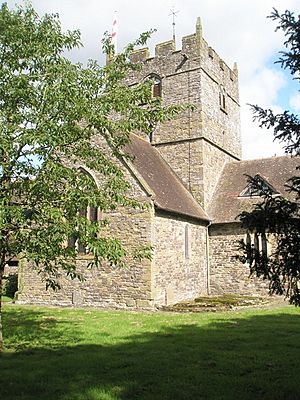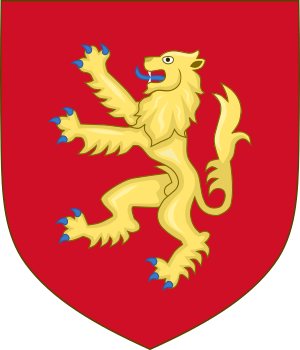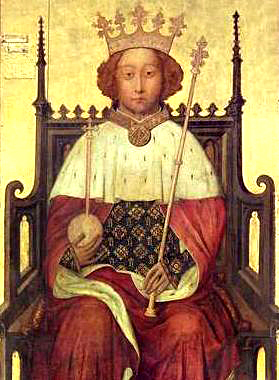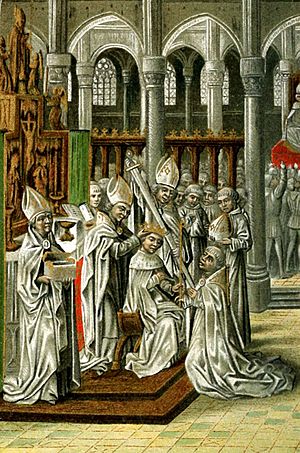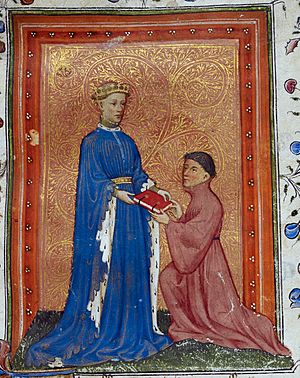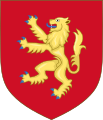John Burley facts for kids
Quick facts for kids
John Burley
|
|
|---|---|
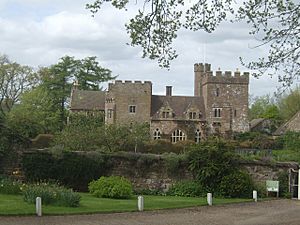
Broncroft Castle today.
|
|
| Member of the English Parliament for Shropshire |
|
| In office 1399–1401 Serving with Thomas Young
Sir Hugh Cheyne |
|
| Preceded by | Richard Chelmswick Sir Fulk Pembridge |
| Succeeded by | 1399: Sir John Cornwall 1401: Sir Adam Peshale |
| In office 1404–1406 Serving with January: George Hawkstone
October: John Darras |
|
| Succeeded by | John Burley, David Holbache |
| In office 1410–1411 Serving with 1410: David Holbache
1411: Sir Adam Peshale |
|
| Preceded by | Sir John Cornwall, David Holbache |
| Succeeded by | Robert Corbet, Richard Lacon |
| Personal details | |
| Born | c. 1360 |
| Died | 1415–16 Broncroft |
| Cause of death | Probably dysentery contracted at Siege of Harfleur |
| Nationality | English |
| Spouse | Juliana |
| Children | William Burley, John Burley, Edmund Burley, one daughter |
| Residence | Broncoft Castle |
| Occupation | Lawyer, landowner, soldier. |
John Burley (who died around 1416) was an important person in England during the late 1300s and early 1400s. He was a lawyer, a soldier, and a Member of Parliament (MP) for Shropshire six different times, starting in 1399.
He also served as a justice of the peace (a judge for local matters) in Shropshire and was the Sheriff of the county from 1408 to 1409. John Burley was a key supporter of the powerful Earl of Arundel. He helped gather soldiers to fight against the Glyndŵr Rising in Wales. He passed away not long after going with the Earl of Arundel on King Henry V's first trip to France.
Contents
Who Was John Burley?
John Burley's early life is a bit unclear. His name was quite common back then. The name "Burley" means a meadow or clearing near a strong place. It was found in many parts of central and northern England.
Some people thought he was the nephew of Simon de Burley, a famous person at court who was executed. But this doesn't seem right, given John Burley's background. He was likely the son of another John Burley from Wistanstow in southern Shropshire. He was also the nephew of John Burnell from Westbury, Shropshire. It seems that in his family, there was often both a lawyer and a church leader in each generation.
His name was spelled in different ways in old documents, like Bureley or Borley. His family's coat of arms showed three boar's heads.
Early Career and Connections
John Burley started his career working with powerful landowners and nobles. He was a "feoffee," which meant he held land for others in trust. This was a way to manage properties and avoid certain taxes.
Working for Sir Richard Ludlow
For about ten years, John Burley worked closely with Sir Richard Ludlow, a very powerful landowner. Burley helped manage Ludlow's many estates. For example, he helped make sure Ludlow's lands would pass to his brother if Ludlow died without children.
Burley also helped Ludlow with church matters, like choosing who would be the new rector (church leader) at Wistanstow. After Ludlow died in 1390, it was found that he technically didn't own any land. This was because he had put all his property in the hands of Burley and other feoffees. This clever trick helped him avoid paying certain taxes to the king.
Serving Important Nobles
Burley became a lawyer for many important noble families in Shropshire. He worked for the Earls of Arundel, Stafford, and March, and the Lords Talbot and Burnell.
In 1387, Burley joined Gilbert Talbot, 3rd Baron Talbot to fight in a naval battle against the French. After Talbot died, Burley helped transfer his estates to his heir. Burley's good service earned him a small estate from Lady Ankaret, Talbot's wife.
He also worked for Hugh Burnell, 2nd Lord Burnell, a powerful lord in central Shropshire. Burnell's second wife brought him a lot of wealth, and Burley helped with the legal process of transferring these new lands. Burnell clearly valued Burley's work, as he later helped Burley's son, Edmund, get a church position.
Burley also served Edmund Stafford, 5th Earl of Stafford, as a steward, managing his household and lands. He was even part of Stafford's council. By 1400, Burley was also working as a steward for the town of Shrewsbury, earning a fee and gifts.
The Arundel Family Connection
The FitzAlan Earls of Arundel were the wealthiest and most important landowners in Shropshire. They had a lot of power in the county's politics. Many of the Members of Parliament from Shropshire were connected to the Earl of Arundel.
The Earl of Arundel gave John Burley some land at Brockton. By 1393, Burley was made the steward of Oswestry, an important town for the Arundel family. In 1395, Burley became a feoffee for the Arundel family's important lands in Chirk. He was also regularly appointed as a justice of the peace (JP) because he served Arundel.
The Fall of King Richard II
In 1397, Richard FitzAlan, 11th Earl of Arundel, a leader against King Richard II, was executed. During this time, Burley continued his normal legal work. He was even reappointed as a justice of the peace in 1398.
When King Richard II's enemies attacked, Shropshire quickly joined them. Burley quickly supported Thomas FitzAlan, the son of the executed earl, when he returned with Henry Bolingbroke in 1399. This led to Henry Bolingbroke becoming King Henry IV.
After the new king took power, Burley's long-time client, Hugh Burnell, was one of the nobles who accepted King Richard II's surrender. Burley became very successful under the new king and the restored Arundel family's power in Shropshire.
Later Career (1399–1415)
For the last 15 years of his career, John Burley was deeply involved with the Arundel family and their work for the new royal family, the House of Lancaster. He was trusted by the new king and was rewarded for his loyalty.
Serving the New King
Burley became a Member of Parliament for the first time in October 1399. This parliament confirmed Henry IV as the new king. It also brought back the Earl of Arundel's lands and titles. During this time, Burley gained the guardianship of Robert Corbet, who later became an important supporter of the Arundel family.
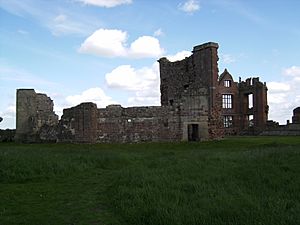
Burley was appointed a justice of the peace in November 1399 and served continuously until 1413. He and Thomas Young were the most regular JPs in the county. As he became more important, Burley also served as the Sheriff of Shropshire in 1409.
More Time in Parliament
The 12th Earl of Arundel kept a strong influence over who represented Shropshire in Parliament. John Burley was elected five more times: in 1401, twice in 1404, in 1410, and finally in 1411. He often served alongside other lawyers and allies of the Arundel family, like John Darras and David Holbache.
Keeping Public Order
Burley was often asked to deal with serious problems and maintain order. In 1402, he was part of a group ordered to fight against people spreading false information about King Henry IV. He also handled cases of murder and serious disturbances, like when poachers attacked a deer park in Shropshire.
He also investigated important property and inheritance cases. These cases could affect the king's interests or public order. For example, he investigated cases where people were suspected of hiding property to avoid taxes.
The Glyndŵr Rising
In 1400, John Burley was with the Earl of Arundel when Owain Glyndŵr was declared a traitor, starting the Glyndŵr Rising (a Welsh revolt).
After the Battle of Shrewsbury in 1403, the king and Arundel fought back against the Welsh. In 1404, Burley, Thomas Young, and Sir John Cornwall were told to supervise the gathering of troops for the campaign in Wales. They were to check the numbers of soldiers and report on nobles already fighting for the king.
These duties continued as the Earl of Arundel was heavily involved in the Welsh campaigns. In 1405, Burley and Cornwall were commissioned to raise more troops for Arundel to protect castles in Wales and Shropshire. They also had to find people in Shropshire who were secretly helping the rebels. Around this time, Burley was even called to a special meeting with the king.
Shrewsbury was a very important city in defending against the Welsh revolt. In 1407, Burley was appointed to a committee to improve the city's defenses. Other members included the Earl of Arundel and the abbot of Shrewsbury Abbey, Thomas Prestbury.
Fighting Against Lollardy
In 1407, Burley was part of a group commissioned to find and imprison anyone "preaching or teaching ideas against the Catholic faith." This was aimed at the Lollard movement, which was a major concern for Archbishop Arundel. The Midlands was known to be a Lollard stronghold. Burley was seen as a reliable supporter of the traditional church. He was a member of the Palmer's Guild of Ludlow, a group that supported church services and helped its members.
Continuing to Serve Arundel
Burley continued to work for the Earl of Arundel on matters concerning his estates. In 1407, when the earl gave Oswestry a new charter, increasing its freedoms and giving it a trade monopoly, Burley's name was first on the list of witnesses.
In 1411, Burley was made Arundel's attorney (legal representative) because the earl was traveling abroad to negotiate a marriage for the Prince of Wales. Burley's close relationship with the earl was strengthened when two of his sons, William and John, also joined the Arundel family's group of supporters.
Landowner
John Burley started from a modest background but became a significant landowner. His properties were mainly in the Corvedale area of Shropshire.
Some of his main estates included:
- Ashfield, where he and his wife acquired two parts of the estate.
- Brockton, an estate that used to belong to the Ludlow family. Burley was the lord of this manor by 1397.
- Strefford, another manor that was once part of the Ludlow estates.
- Munslow, where Burley bought the lordship from Lord Bergavenny.
- Broncroft, where John Burley or his son William built a large home that looked like a castle.
- Properties in the Acton Scott parish, including land at Alcaston and Henley.
- Alveley, where he owned property that would later help fund a special church service for him.
Death and Family
In 1414, John Burley began setting up a "chantry" for himself and his wife, Juliana. This meant he gave property to Shrewsbury Abbey. In return, the abbey promised to have a priest say mass daily for Burley and Juliana in the chapel of St Katharine.
In July 1415, he joined Thomas Fitzalan, 12th Earl of Arundel on King Henry V's first trip to France. They went to the Siege of Harfleur. During the siege, many soldiers got sick with dysentery. Both Burley and Arundel became ill and had to return home. They did not take part in the famous Battle of Agincourt. Arundel died in October 1415. Burley returned to England on October 4.
Burley made a verbal will in October 1415, which suggests he was very sick. He confirmed that his property should go to his legal heirs. He left his movable belongings to his executors, Richard Lacon and Roger Corbet. His will was officially approved on February 18, 1416, meaning he must have died before that date.
Marriage and Children
John Burley's wife was named Juliana. She was often involved in his property deals. Some old books suggested she was related to a powerful noble family, the Greys. However, there is no clear proof of this. The Burley family and the Grey family were from very different social classes.
John and Juliana Burley had at least three sons and one daughter:
- William Burley: He was John Burley's main heir and later became the Speaker of the House of Commons.
- John Burley: He was also a member of the Arundel family's group of supporters.
- Edmund Burley: He was a church leader and was given a position at Holdgate by Hugh Burnell.
Images for kids


